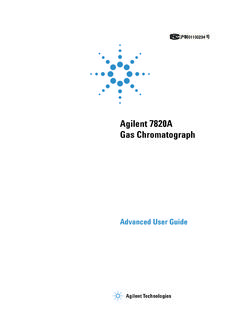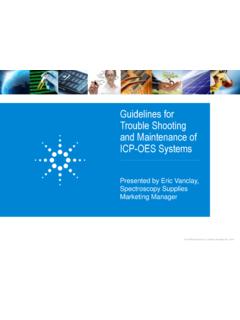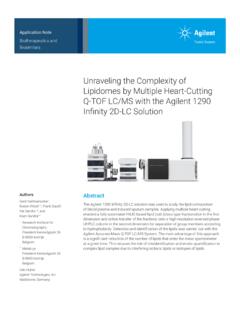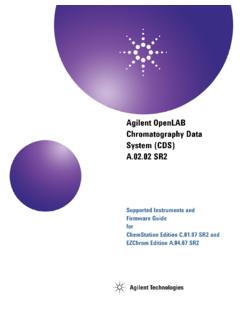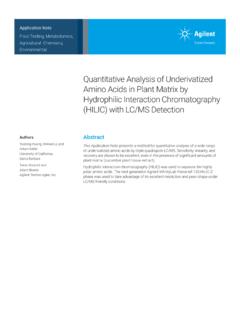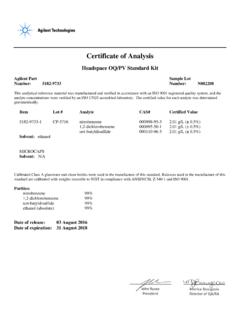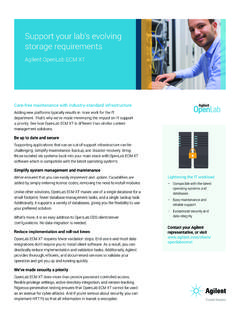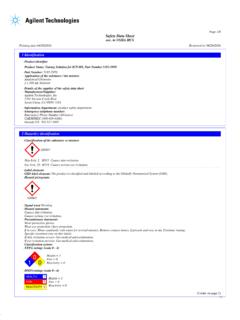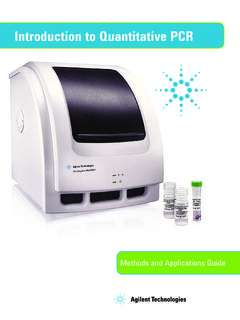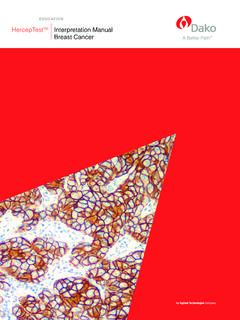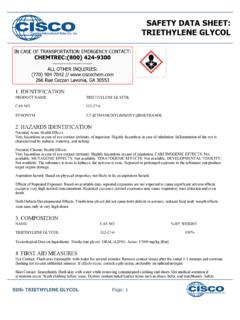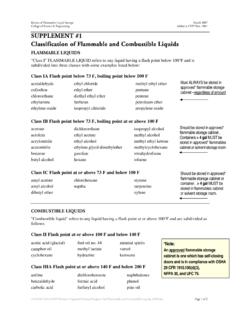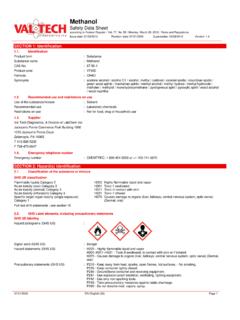Transcription of How to select the correct GC column - Agilent
1 How to Choose the correct Type and DimensionSimon JonesApplication EngineerThe GC ColumnThings to TitleAgilent RestrictedPage 2 Things to Is it Volatile enough to chromatograph by GC?Group/Presentation TitleAgilent RestrictedPage 2 Things to Is it Volatile enough to chromatograph by GC? Is it a Gas or a Liquid?Group/Presentation TitleAgilent RestrictedPage 2 Things to Is it Volatile enough to chromatograph by GC? Is it a Gas or a Liquid? How are we getting the Sample Injected?Group/Presentation TitleAgilent RestrictedPage 2 Things to Is it Volatile enough to chromatograph by GC? Is it a Gas or a Liquid? How are we getting the Sample Injected? What is the sample Matrix?Group/Presentation TitleAgilent RestrictedPage 2 Things to Is it Volatile enough to chromatograph by GC? Is it a Gas or a Liquid? How are we getting the Sample Injected? What is the sample Matrix? Can we do sample clean up?Group/Presentation TitleAgilent RestrictedPage 2 Things to Is it Volatile enough to chromatograph by GC?
2 Is it a Gas or a Liquid? How are we getting the Sample Injected? What is the sample Matrix? Can we do sample clean up? Is it an established method?Group/Presentation TitleAgilent RestrictedPage 2 Things to Is it Volatile enough to chromatograph by GC? Is it a Gas or a Liquid? How are we getting the Sample Injected? What is the sample Matrix? Can we do sample clean up? Is it an established method?--EPA, ASTM, USPG roup/Presentation TitleAgilent RestrictedPage 2 Things to Is it Volatile enough to chromatograph by GC? Is it a Gas or a Liquid? How are we getting the Sample Injected? What is the sample Matrix? Can we do sample clean up? Is it an established method?--EPA, ASTM, USP What do we Know about the analytes?Group/Presentation TitleAgilent RestrictedPage 2 Things to Is it Volatile enough to chromatograph by GC? Is it a Gas or a Liquid? How are we getting the Sample Injected? What is the sample Matrix? Can we do sample clean up? Is it an established method?
3 --EPA, ASTM, USP What do we Know about the analytes? What else MAY be present in the sample?Group/Presentation TitleAgilent RestrictedPage 2 Things to Is it Volatile enough to chromatograph by GC? Is it a Gas or a Liquid? How are we getting the Sample Injected? What is the sample Matrix? Can we do sample clean up? Is it an established method?--EPA, ASTM, USP What do we Know about the analytes? What else MAY be present in the sample?Group/Presentation TitleAgilent RestrictedPage 2 Group/Presentation TitleAgilent RestrictedPage 3 CAPILLARY column TYPESL iquid PhaseCarrier GasPorous Layer Open Tube (PLOT)Wall Coated Open Tube (WCOT)Solid ParticlesCarrier GasPacked ColumnsPacked column Designs and Materials1950 Introduction with the first gas chromatographsPacked column AnatomyPacked Columns 1 12 m length Internal Diameter 4mm Tubing Stainless Steel, UltimetalTMSS, Glass, Nickel, PTFEP acked column AnatomyPacked Columns 1 12 m length Internal Diameter 4mm Tubing Stainless Steel, UltimetalTMSS, Glass, Nickel, PTFE Packing Coated packing Inert, solid support (diatomaceous earth) coated with liquid stationary phase ( OV-1, SE-30, Carbowax 20M, FFAP) Porous packing Porous polymers (PoraPak Q, N, HayeSep Q, R, S, etc.)
4 Porous carbons (Carboxens, Carbosieves, Carbotraps)Packed column AnatomyPacked Columns 1 12 m length Internal Diameter 4mm Tubing Stainless Steel, UltimetalTMSS, Glass, Nickel, PTFE Packing Coated packing Inert, solid support (diatomaceous earth) coated with liquid stationary phase ( OV-1, SE-30, Carbowax 20M, FFAP) Porous packing Porous polymers (PoraPak Q, N, HayeSep Q, R, S, etc.) Porous carbons (Carboxens, Carbosieves, Carbotraps)WCOT CapillaryPacked column AnatomyPacked Columns 1 12 m length Internal Diameter 4mm Tubing Stainless Steel, UltimetalTMSS, Glass, Nickel, PTFE Packing Coated packing Inert, solid support (diatomaceous earth) coated with liquid stationary phase ( OV-1, SE-30, Carbowax 20M, FFAP) Porous packing Porous polymers (PoraPak Q, N, HayeSep Q, R, S, etc.) Porous carbons (Carboxens, Carbosieves, Carbotraps)WCOT CapillaryPLOT CapillaryGroup/Presentation TitleAgilent RestrictedPage 6 STATIONARY PHASE POLYMERSSiRROSiRROSiRRSiRROnmOSiRRnSilox aneSiarylene backboneR= methyl , phenyl, cyanopropyl, trifluoropropylOHCH2CH2O nPolyethylene GlycolStationary Phase% Substitution --polysiloxanesGroup/Presentation TitleAgilent RestrictedPage 7% = # of sites on silicon atoms occupiedBalance is methylOSiRRnSiloxaneR= methyl , phenyl, cyanopropyl, trifluoropropylStationary PhasePoly(ethylene) GlycolGroup/Presentation TitleAgilent RestrictedPage 8100% PEG (DB-WAX)Less stable than polysiloxanesUnique separation characteristicsHOCH2CH2 OHnPoly(Ethylene) GlycolModifiedGroup/Presentation TitleAgilent RestrictedPage 9 Base deactivated (CAM) Acid Modified (DB-FFAP)
5 Extended Temperature RangeWCOT column Types Mexico 2012 Agilent J&W has over 50 different stationary phase offeringsPLOT columns are primarily, but not exclusively, used for the analysis of gases and low boiling point solutes ( , boiling point of solute is at or below room temperature).PLOT column Types Agilent J&W PLOT columns begin with the designation of GS (Gas Solid) or HP-PLOT followed by a specific name CP (ChromPack) followed by name 10 stationary phases GS-OxyPLOT/ CP-Lowox GS-Alumina HP-PLOT Al2O3 M HP-PLOT Al2O3 S HP-PLOT Al2O3 KCl / CP-AL2O3/KCl HP-PLOT MoleSieve/ CP-Molsieve5A GS-CarbonPLOT/ CP-CarboBOND HP-PLOT Q / CP PoraBONDQ HP-PLOT U / CP-PoraBONDU GS-GasPro/ CP-SilicaPLOT GS-OxyPLOT: oxygenates HP-PLOT Molesieve: O2, N2, CO, Methane HP-PLOT Alumina and GS-Alumina: complex hydrocarbon gas matrices, ethylene and propylene purity, 1,4-butadiene HP-PLOT Q: freons, sulfides HP-PLOT U: C1 to C7 hydrocarbons, CO2, Polar Hydrocarbons GS-GasPro: freons, sulfurs, inorganic gases GS-CarbonPLOT.
6 Inorganic and organic gasesIntegrated Particle Trap PLOT ColumnsGroup/Presentation TitleAgilent RestrictedPage 12 Particle trap is on both ends of the columnOn the front end to help facilitate backflushingwithout blowing particles back into the inlet / valveSpecialty PhasesGroup/Presentation TitleAgilent RestrictedPage 13 Columns developed for particular applicationsExamples: DB-UI 8270D, DB-624UI <467>,DB-VRX, DB-MTBE, DB-TPH, DB-ALC1, DB-ALC2, DB-HTSimDis, DB-Dioxin, select Low Sulfur, CP-Volamine, select PAH, DB-EUPAH, DB-CLP1 & 2, DB- select 624 UI 467, CP-LowOx, select Permanent Inert PhasesGroup/Presentation TitleAgilent RestrictedPage 14DB-1msUIHP-1msUIDB-5msUIHP-5msUIDB-17m sUIDB-624 UIDB- select 624UI 467DB-WAXUISame Selectivity, more Inertness!Three Types Of Low Bleed PhasesGroup/Presentation TitleAgilent RestrictedPage 15 Phases tailored to mimic currently existing polymersExamples: DB-5ms, DB-35ms, DB-17ms, VF-1701ms New phases unrelated to any previously existing polymersExamples: DB-XLB Optimized manufacturing processesDB-1ms, HP-1ms, HP-5ms, VF-5msSiRROSiRROSiRRSiRROnmSiarylene backboneWhat is column Bleed?
7 ?? Back Biting Mechanism of Product FormationGroup/Presentation TitleAgilent RestrictedPage 16+RepeatSiSiSiSiSiSiSiOOOOOOOHCH3CH3CH3 CH3CH3CH3CH3CH3CH3CH3CH3CH3CH3CH3 OHSiSiOSiOSiOCH3CH3CH3CH3CH3CH3CH3CH3 SiOOOCH3H3CH3CH3 CSiSiCH3CH3 OOOOOOSiHOH3 CCH3CH3CH3CH3 SiSiSiSiSiSiCH3CH3CH3CH3CH3CH3CH3CH3CH3 Cyclic products are thermodynamically more stable!DB-5ms StructureGroup/Presentation TitleAgilent RestrictedPage 17CH3 SiSiSiSiOOOODB-5 StructureDB-55% PhenylSiSiSiSiOODB-5ms to match DB-5CH3CH3CH3CH3CH3CH3CH3CH3CH3CH3CH3CH3 DB-35MS VS STANDARD 35% PHENYLB enzo[g,h,i]perylene, 1ngGroup/Presentation TitleAgilent RestrictedMonth ##, 35% PhenylDB-35msGroup/Presentation TitleAgilent RestrictedPage 19 Solid line:DB-5ms 30 m x .25 mm x .25 mmDashed line: DB-5 30 m x .25 mm x .25 mmOven:60oC isothermalCarrier gas: H2at 40 cm/sec1: Ethylbenzene2: m-Xylene3: p-Xylene4: o-XyleneChromatograms are offset on x-axisfor easier viewingWhy is stationary phase type important?
8 Group/Presentation TitleAgilent RestrictedPage 20k2= partition ratio of 2ndpeakk1= partition ratio of 1stpeakInfluence on 12kk= RsNkk=411+ - SelectivityGroup/Presentation TitleAgilent RestrictedPage 21 Relative spacing of the chromatographic peaks The result of all non-polar, polarizable and polar interactions that cause a stationary phase to be more or less retentive to one analytethan anotherOptimizing Selectivity ( )Match analytepolarity to stationary phase polarity- like dissolves like Take advantage of unique interactions between analyteand stationary phase functional groupsGroup/Presentation TitleAgilent RestrictedPage 22 AnalytePolarityGroup/Presentation TitleAgilent RestrictedPage 23 Nonpolar Molecules-generally composed of only carbon and hydrogen and exhibit no dipole moment (Straight-chained hydrocarbons (n-alkanes))Polar Molecules-primarily composed of carbon and hydrogen but also contain atoms of nitrogen, oxygen, phosphorus, sulfur, or a halogen (Alcohols, amines, thiols, ketones, nitriles, organo-halides, etc.)
9 Includes dipole-dipole interactions and H-bonding)Polarizable Molecules-primarily composed of carbon and hydrogen, but also contain unsaturated bonds (Alkenes, alkynes and aromatic compounds)Selectivity InteractionsGroup/Presentation TitleAgilent RestrictedPage 24 Dispersion Dipole Hydrogen bondingDispersion InteractionDHvapGroup/Presentation TitleAgilent RestrictedPage 25 Separation by differences in analyteheat of vaporizations ( DHvap) Heat necessary to convert a liquid into a gas(at the same temperature)Dispersion Interaction Solubility And RetentionGroup/Presentation TitleAgilent RestrictedPage 2630 m x mm ID, mHe at 35 cm/sec50-170 C at 15 /min100% PEG(polar)100% methyl (non-polar)C10C12 Hexanol02468 HexanolC10C1202468 Hexanol158oCDecane174oCDodecane216oCDisp ersion Interaction DHvapGroup/Presentation TitleAgilent RestrictedPage 27 Vapor pressure: good approximationBoiling point: poor approximationDipole InteractionSmaller differences require a stronger dipole phaseGroup/Presentation TitleAgilent RestrictedPage 28C18:1 ( methyl trans-9-octadecenoate)C18:1 ( methyl cis-9-octadecenoate) 186 186 CFames 37 Component StandardGroup/Presentation TitleAgilent RestrictedPage 29 column : DB-2360 m X mm X mAgilent P/N 122-2361 Carrier:He , 33 cm/sec @ 50oCOven:50oC for 1 min25oC/min to 175 (no hold)4oC/min to 230oC hold 5 minInjector:250oC, Split 50:1, 1uLDetector:FID, 250oCC18:1 ( methyl trans-9-octadecenoate)C18:1 ( methyl cis-9-octadecenoate)1221 Hydrogen Bonding InteractionDipole-Dipole interaction with H bound to O or N interacting with an O or NGroup/Presentation TitleAgilent RestrictedPage 30+-OOHHHHNONPOLAR PHASEST ypified by 100% polydimethylsiloxanessuch as HP-1, DB-1, DB-1ms, HP-1ms,VF-1ms, CP-Sil5 CBGroup/Presentation TitleAgilent RestrictedPage 31 SiMeMeOnSeparation Mechanisms.
10 -Dispersion onlyPOLARIZABLE PHASEST ypified by phenyl substituted siloxanes, substituted at 5-50% (HP-5, HP-5ms, DB-35, DB-35ms, DB-17, DB-17ms)Group/Presentation TitleAgilent RestrictedPage 32 SiMeMeOmOSiOPhPhn5%--weakly polar,rest--mid polarSeparation Mechanisms:-Dispersion-Inducible dipole at phenyl groupsSTRONG DIPOLE PHASEST ypified by cyanopropylor trifluoropropylsubstituted siloxanes, substituted 6-50% (DB-1701, DB-1301, DB-200, DB-23, DB-225)Group/Presentation TitleAgilent RestrictedPage 33 SiMeMeOnOSiORR'mR = cyanopropyl or trifluoropropylR = phenyl or methylSeparation Mechanisms:-Dispersion-Inducible dipole at phenyl groups-Strong permanent dipole-Hydrogen bondingHYDROGEN BONDING PHASEST ypified by polyethylene glycol polymers (Carbowax, HP-INNOWax, DB-WAX, DB-FFAP, VF-WAXms, )Group/Presentation TitleAgilent RestrictedPage 34 HOHH--C -C -O --HHHnSeparation Mechanisms:-Dispersion-Strong permanent dipole-Hydrogen bondingSelectivityInteraction StrengthsGroup/Presentation TitleAgilent RestrictedPage 35 PhaseDispersionDipoleH BondingMethylStrongNoneNonePhenylStrongN oneWeakCyanopropylStrongVery StrongModerateTrifluoropropylStrongModer ateWeakPEGS trongStrongModeratePolarityGroup/Present ation TitleAgilent RestrictedPage 36 PolarityStabilityTemperature RangeCompounds & PropertiesGroup/Presentation TitleAgilent RestrictedPage 37 CompoundsPolarAromaticHydrogenBondingDip oleToluenenoyesnoinducedHexanolyesnoyesy esPhenolyesyesyesyesDecanenonononoNaphth alenenoyesnoinducedDodecanenononono100% methyl PolysiloxaneGroup/Presentation TitleAgilent RestrictedPage 38 Strong DispersionNo DipoleNo H Bonding1.
